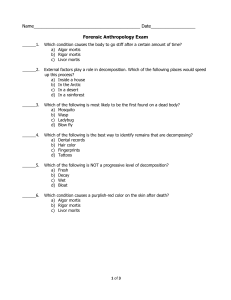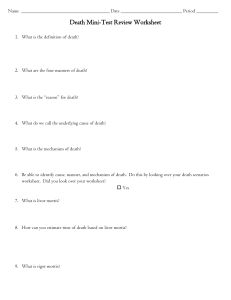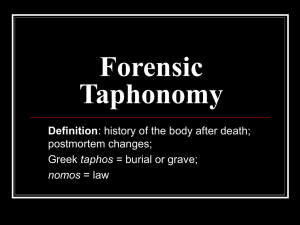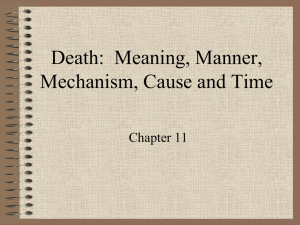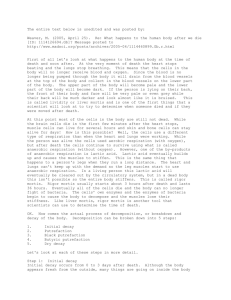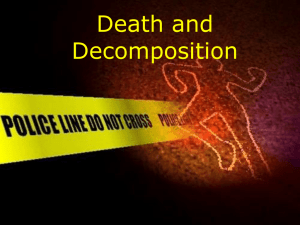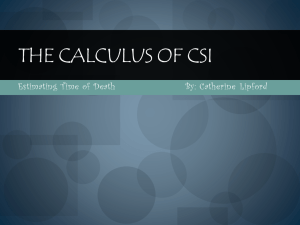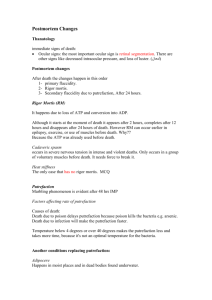230212_Determining_ToD
advertisement
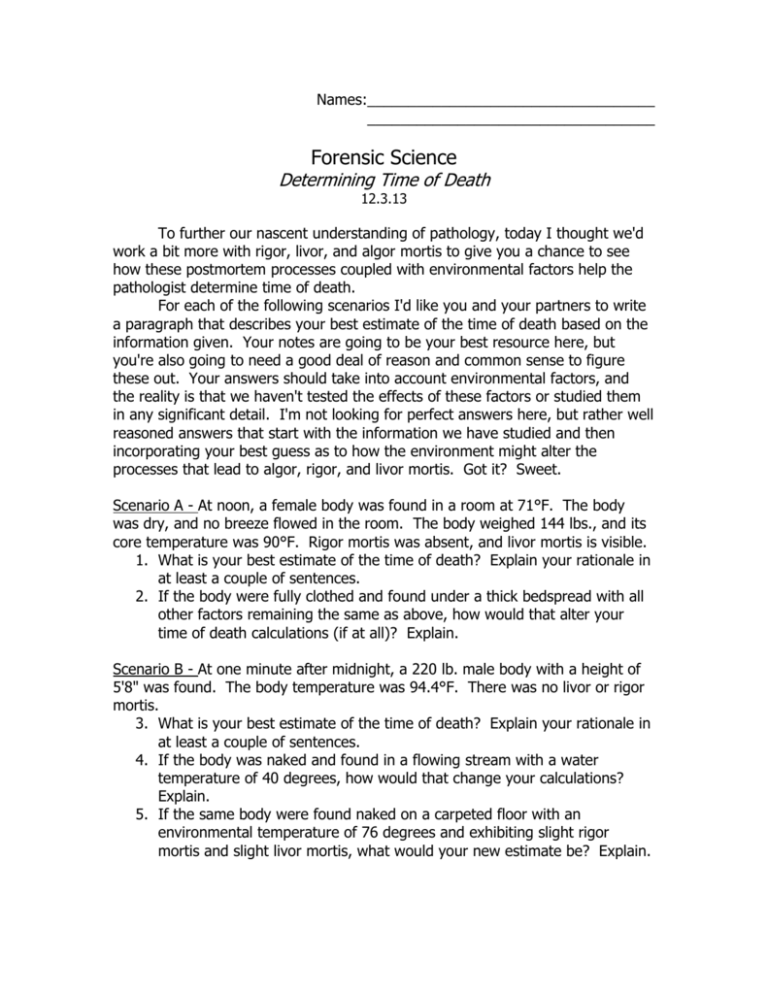
Names:___________________________________ ___________________________________ Forensic Science Determining Time of Death 12.3.13 To further our nascent understanding of pathology, today I thought we'd work a bit more with rigor, livor, and algor mortis to give you a chance to see how these postmortem processes coupled with environmental factors help the pathologist determine time of death. For each of the following scenarios I'd like you and your partners to write a paragraph that describes your best estimate of the time of death based on the information given. Your notes are going to be your best resource here, but you're also going to need a good deal of reason and common sense to figure these out. Your answers should take into account environmental factors, and the reality is that we haven't tested the effects of these factors or studied them in any significant detail. I'm not looking for perfect answers here, but rather well reasoned answers that start with the information we have studied and then incorporating your best guess as to how the environment might alter the processes that lead to algor, rigor, and livor mortis. Got it? Sweet. Scenario A - At noon, a female body was found in a room at 71°F. The body was dry, and no breeze flowed in the room. The body weighed 144 lbs., and its core temperature was 90°F. Rigor mortis was absent, and livor mortis is visible. 1. What is your best estimate of the time of death? Explain your rationale in at least a couple of sentences. 2. If the body were fully clothed and found under a thick bedspread with all other factors remaining the same as above, how would that alter your time of death calculations (if at all)? Explain. Scenario B - At one minute after midnight, a 220 lb. male body with a height of 5'8" was found. The body temperature was 94.4°F. There was no livor or rigor mortis. 3. What is your best estimate of the time of death? Explain your rationale in at least a couple of sentences. 4. If the body was naked and found in a flowing stream with a water temperature of 40 degrees, how would that change your calculations? Explain. 5. If the same body were found naked on a carpeted floor with an environmental temperature of 76 degrees and exhibiting slight rigor mortis and slight livor mortis, what would your new estimate be? Explain. Scenario C - A 180 lb. male body was found outside the school this morning at 6:15am. It's about 34 degrees outside and the wind has died down, but it was windy all weekend. No rigor mortis is present, livor mortis is well developed but not fixed, and the body's temperature was measured at 71 degrees. The body is heavily clothed and is laying on an icy sidewalk. Nobody has walked down this sidewalk since Friday afternoon and the last confirmed sighting of this person was Friday evening around 6:00pm. 6. What is your best estimate of the time of death? Explain your rationale in at least a couple of sentences. Get one of the netbooks and go to Mr. Mason's website. Follow the link labeled Pathology - Time of Death Calculator. This calculator is somewhat difficult to read in that the results are going to be partially cut off on the lower left side of the screen, but I think you should be able to make it work. (You may have to reload the page between scenarios, as some of the buttons can't be unchecked after you've checked them once.) 7. Go back to scenario A and enter the information into the calculator including all factors mentioned in question #2. What is the time of death given by the calculator? How far off were you? If there was a significant difference, what might explain that? Were there any factors that you might not have considered correctly? (Be detailed here...I don't expect your first answer to be perfectly correct, but rather I hope that you're learning something here about how these factors interplay with postmortem processes.) 8. Do the same thing for the second part of Scenario B (question #4) and explain what factors might have influenced any significant variation between your original estimate and the calculated time of death. 9. Do the same thing for Scenario C and explain what factors might have influenced any significant variation between your original estimate and the calculated time of death. 10. Put together a scenario for each group member that would lead to their body having been dead for 20 hours. Test each situation with the calculator to be sure it works out correctly. Example: Mr. Mason weighs 170 pounds, was found wearing two thin layers of clothing while lying in the snow. Livor mortis was present but not fixed and slight rigor mortis was present. It was windy outside with a temperature of 24 degrees. His core body temperature was 61 degrees. (I totally made that up off the top of my head, but the estimate came out at 20.5 hours. I rock. If you're off on your first scenario, adjust the factors until you get it within an hour of 20. Additionally, try to make the situation for each group member reasonably different.)
